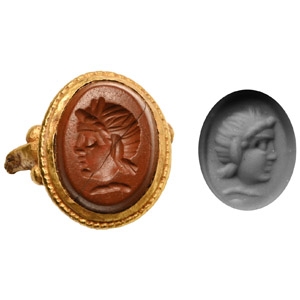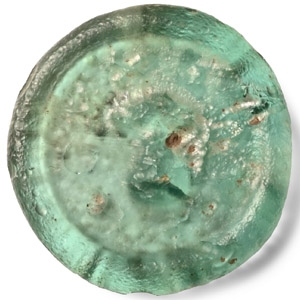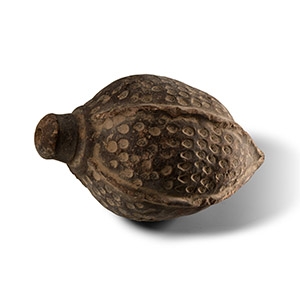Home > Auctions > 4 June - 8 June 2024
Ancient Art, Antiquities, Natural History & Coins
Auction Highlights:
From the Fadel family collection, London, UK, 1970s.
From the collection of a gentleman, acquired on the London art market in the 1990s.
Cf. for some of the represented symbols on medallions Wamser, L., Die Welt von Byzanz - Europas Östliches Erbe, München, 2004, items 577, 582, 585.
The amulet has a prophylactic element asking the divine protection of a military saint (probably Saint Sisinnius, or Saint George or Saint Theodore) with the inscription 'Winning for God'. The amulet seems to belong to a certain Konstantinos, probably a soldier.
From a specialist collection of militaria, London, UK, collected 1990s onwards.
Accompanied by an academic paper by military specialist Dr Raffaele D'Amato, dated 15 July 2019 and titled 'Eastern Roman Empire - Greek Fire Bomb or Hand Grenade (μεσαίον kακάβιον) 9th-11th century AD'.
Cf. Arendt, W. I., Granaten des 13-14. Jahrhunderts, die an der Wolga gefunden sind, Zeitschrift fur Historische Waffen-und Kostumkunde, 11 (1926-8), p.42; cf. Arendt, W., Die Spharisch-konischen Gefäße aus Gebranntem Ton, ibid; cf. Ayalon, D., Gunpowder and Firearms in the Mamluk Kingdom, London, 1956, p.16.
Apart from the use of siphons or manual flame-throwers called cheirosiphona, special corps of Roman soldiers employed terracotta grenades, in the form of small jars, abundantly evidenced in archaeological excavations. They were called μεσαία kακαβιά or κυτροκακάβια where the former had a bulbous shape and the latter a more cylindrical form.
From the property of late Mr SM, London, UK, 1969-1999.
From the collection of a gentleman, acquired on the London art market in the 1990s.
Acquired on the London, UK, art market in the 1990s.
From a gentleman's private collection.
Cf. Tal, O., Piasetzky-David, M., ‘Inscribed Spindle Whorls from a Byzantine Burial Cave at Yavne-Yam, Israel’ in Israel Exploration Journal, vol.70, no.1 (2020), pp.106-113, for similar example in stone (basalt).
Similar objects could have been manufactured to look like spindle whorls, while they were in fact used as beads and/or amulets. The current evidence may suggest that these items were burial goods for females. They are sometimes seen incised with Greek letters and symbols that seem to suggest a cryptic onomata barbara formula. In this context, they can be viewed as mystical objects with the function of transmitting a message to the Other World, and the sheer mass of letters intended to convey the idea of an authoritative communication inaccessible to ordinary human being.
From a specialist collection of militaria, London, UK, collected 1990s onwards.
Accompanied by an academic paper by military specialist Dr Raffaele D'Amato, dated 15 July 2019 and titled 'Eastern Roman Empire - Greek Fire Bomb or Hand Grenade (μεσαίον kακάβιον) 9th-11th century AD'.
Cf. Arendt, W. I., Granaten des 13-14. Jahrhunderts, die an der Wolga gefunden sind, Zeitschrift fur Historische Waffen-und Kostumkunde, 11 (1926-8), p.42; cf. Arendt, W., Die Spharisch-konischen Gefäße aus Gebranntem Ton, ibid; cf. Ayalon, D., Gunpowder and Firearms in the Mamluk Kingdom, London, 1956, p.16.
Apart from the use of siphons or manual flame-throwers called cheirosiphona, special corps of Roman soldiers employed terracotta grenades, in the form of small jars, abundantly evidenced in archaeological excavations. They were called μεσαία kακαβιά or κυτροκακάβια where the former had a bulbous shape and the latter a more cylindrical form.
From the collection of a North American gentleman, formed in the 1990s.
Cf. Papanikola-Bakirtzi, D. (ed.), Everyday life in Byzantium. Byzantine Hours. Works and days in Byzantium, Exhibition catalogue, Thessaloniki, White Tower October 2001-January 2002, Athens, 2002, no.488, for similar.
In the late Byzantium period, round-shaped buckles and horse harness mounts were often decorated with beaded edges and with floral embossed ornaments, under the influence of the Ottoman Turks. They have the shape of a small shield and impressed decoration of a rose. Belt appliques have an extra boss for attachment, instead of a loop which is usually attached to the horse harness pendants.
Acquired 1980-2015.
Ex Abelita family collection.
Acquired 1980-2015.
Ex Abelita family collection.
Cf. Chadour, A.B., Rings. The Alice and Louis Koch Collection, volume I, Leeds, 1994, item 481.
The meaning of the inscription is not clear, although it may be prophylactic, with the letter Chi (Χ) linked with the rho (P) i.e. XP for ‘Christ’ and the other letters referring to the usual expression βΟYTICΗ (protect) βOΥΛIΟ (Doulo? ), therefore intended to be read ‘Christ protect your servant’. The ring was probably engraved by a foreigner with a very limited understanding of Greek.
From a specialist collection of militaria, London, UK, collected 1990s onwards.
Accompanied by an academic paper by military specialist Dr Raffaele D'Amato, dated 15 July 2019 and titled 'Eastern Roman Empire - Greek Fire Bomb or Hand Grenade (μεσαίον kακάβιον) 9th-11th century AD'.
Cf. Arendt, W. I., Granaten des 13-14. Jahrhunderts, die an der Wolga gefunden sind, Zeitschrift fur Historische Waffen-und Kostumkunde, 11 (1926-8), p.42; cf. Arendt, W., Die Spharisch-konischen Gefäße aus Gebranntem Ton, ibid; cf. Ayalon, D., Gunpowder and Firearms in the Mamluk Kingdom, London, 1956, p.16.
Apart from the use of siphons or manual flame-throwers called cheirosiphona, special corps of Roman soldiers employed terracotta grenades, in the form of small jars, abundantly evidenced in archaeological excavations. They were called μεσαία kακαβιά or κυτροκακάβια where the former had a bulbous shape and the latter a more cylindrical form.
Acquired on the UK art market.
Property of a Ruislip, UK, gentleman, by inheritance.
Cf. Schulze-Dörrlamm, M., Byzantinische Gürtelschnallen und Gürtelbeschläge im Römisch-Germanischen Zentralmuseum. Teil 2. Die Schnallen mit Scharnierbeschläg und Schnallen mit angegossenem Riemendurchzug des 7. bis 10. Jahrhunderts, Mainz, 2009, pp.9ff, fig.227.
The fragment of the simpler Maltese cross mount corresponds to the type E2 of Schulze-Dörrlamm, here with straight arms with rounded corners. It resembles the cross-shaped hinge fittings of the belt buckles from Herrera de Pisuerga and tomb 9 from El Tesorillo from Visigoth Spain, two bronze fittings from Lusitania and the buckle with busts of saints and the Greek inscription 'Light and Life' from Korbous in Tunisia. These kind of buckles were also found in male warrior graves.
769 - 780 of 2809 LOTS

.jpg)

.jpg)
.jpg)
.jpg)







.jpg)



.jpg)



